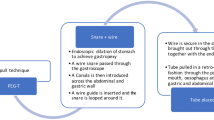Abstract
Purpose
Gastrostomy buttons are normally inserted in two stages. For children, both stages are performed under general anaesthetic (GA) in the UK. We report our 20 years experience of the SPRING technique. (Single stage, Percutaneous, Rapid INsertion of a Gastrostomy button).
Method
This paper retrospectively analysed case notes of all children who underwent a SPRING procedure between 1994 and 2014 in our institute. Patient details, success of placement, recovery process and early post-operative complications were recorded. A gastroscope is passed, and two Cope Gastrointestinal Anchor Sutures positioned. A dilator and splittable sheath are passed over a guide wire, the dilator is removed and a button inserted.
Results
300 patients underwent a GA for SPRING procedure.190 had a neurological diagnosis, 39 had Cystic Fibrosis, 16 had renal failure, and 55 had miscellaneous diagnoses. The age range was 3–238 months and their weights ranged from 3.0 to 128 kg. Of 300 attempts, 287 (95.6%) were successfully inserted. 12 required a 2.5 cm mini-laparotomy to identify the stomach and in one case the procedure was abandoned. Fourteen (4.9%) had a major complication requiring a 2nd GA and seventeen (5.9%) had minor surgical complications not requiring GA. The overall complication rate was 10.8%.
Conclusion
SPRING technique is a simple method for single stage gastrostomy button insertion with an acceptable complication rate.

Similar content being viewed by others
References
Gauderer MW, Ponsky JL, Izant RJ (1980) Gastrostomy without laparotomy: a percutaneous endoscopic technique. J Pediatr Surg 15:872–875
Rothenberg SS, Bealer JF, Chang JHT (1999) Primary laparoscopic placement of gastrostomy buttons for feeding tubes: a safer and simpler technique. Surg Endosc 13:995–997
Guruswamy V, Barbour R (2015) Anaesthesia for children with renal disease. BJA Education 15:6
Fitzgerald M, Ryan D (2011) Cystic fibrosis and anaesthesia. Contin Educ Anaesth Crit Care Pain 11:6
Prosser DP, Sharma N (2010) Cerebral palsy and anaesthesia. Contin Educ Anaesth Crit Care Pain 10:3
Jacob A, Delesalle D, Coopman S, Bridenne M, Guimber D, Turck D et al (2015) Safety of the one-step percutaneous endoscopic gastrostomy button in children. J Pediatr 166:1526–1528
Griffiths M (1996) Single-stage percutaneous gastrostomy button insertion: a leap forward. J Parenter Enter Nutr 20:237–239
Craig GM, Carr LJ, Cass H, Hastings RP, Lawson M, Reilly S et al (2006) Medical, surgical, and health outcomes of gastrostomy feeding. Dev Med Child Neurol 48:353–360
Balogh B, Kovács T, Saxena AK (2019) Complications in children with percutaneous endoscopic gastrostomy (PEG) placement. World J Pediatr 15:12
Gauderer MWL (2001) Percutaneous endoscopic gastrostomy—20 years later: a historical perspective. J Pediatr Surg 36:217–219
Gastrostomy management guidelines. Great Ormond Street Hospital. https://www.gosh.nhs.uk/health-professionals/clinical-guidelines/gastrostomy-management. Accesses 12 July 2019.
Zamakhshary M, Jamal M, Blair GK, Murphy JJ, Webber EM, Skarsgard ED (2005) Laparoscopic vs percutaneous endoscopic gastrostomy tube insertion: a new pediatric gold standard? J Pediatr Surg 40:859–862
Akay B, Capizzani TR, Lee AM, Drongowski RA, Geiger JD, Hirschl RB et al (2010) Gastrostomy tube placement in infants and children: is there a preferred technique? J Pediatr Surg 45:1147–1152
McSweeney ME, Kerr J, Jiang H, Lightdale JR (2015) Risk factors for complications in infants and children with percutaneous endoscopic gastrostomy tubes. J Pediatr 166(6):1514–9.e1
Treem WR, Etienne NL, Hyams JS (1993) Percutaneous endoscopic placement of the “button” gastrostomy tube as the initial procedure in infants and children. J Pediatr Gastroenterol Nutr 17:382–386
Griffiths M (1995) Primary percutaneous insertion of gastrostomy button. Lancet 345(8955):981–982
Evans JS, Thorne M, Taufiq S, George DE (2006) Should single-stage PEG buttons become the procedure of choice for PEG placement in children? Gastrointest Endosc 64:320–324
Novotny NM, Vegeler RC, Breckler FD, Rescorla FJ (2009) Percutaneous endoscopic gastrostomy buttons in children: superior to tubes. J Pediatr Surg 44:1193–1196
Heuschkel RB, Gottrand F, Devarajan K, Poole H et al (2015) ESPGHAN Position statement on the management of percutaneous endoscopic gastrostomy in children and adolescents. J Pediatr Gastroenterol Nutr 60(1):131–141
Göthberg G, Björnsson S (2016) One-step insertion of low-profile gastrostomy in pediatric patients vs pull percutaneous endoscopic gastrostomy: retrospective analysis of outcomes. J Parenter Enteral Nutr 40(3):423–430
Vervloessem D, van Leersum F, Boer D, Hop WCJ, Escher JC, Madern GC et al (2009) Percutaneous endoscopic gastrostomy (PEG) in children is not a minor procedure: risk factors for major complications. Semin Pediatr Surg 18:93–97
Baker L, Beres AL, Baird R (2015) A systematic review and meta-analysis of gastrostomy insertion techniques in children. J Pediatr Surg 50:718–725
Kvello M, Knatten CK, Perminow G et al (2018) Initial experience with percutaneous endoscopic gastrostomy with T-fastener fixation in pediatric patients. Endosc Int Open 6(2):E179–E185
Funding
This Study did not get any funding.
Author information
Authors and Affiliations
Contributions
AD, PC, MG contributed to the conception and design of the research and drafting the manuscript; AD, HW critically revised the manuscript; AL contributed to the acquisition, analysis and interpretation of the data; and AD, PC drafted the manuscript. All authors critically revised the manuscript, agree to be fully accountable for ensuring the integrity and accuracy of the work, and read and approved the final manuscript.
Corresponding author
Ethics declarations
Conflict of interest
The authors report no conflict of interest.
Ethical approval
All procedures performed in studies involving human participants were in accordance with the ethical standards of the institutional and/or national research committee and with the 1964 Helsinki Declaration and its later amendments or comparable ethical standards.
Informed consent
For this retrospective study formal consent is not required.
Clinical relevancy statement
Gastrostomy buttons are normally inserted in two stages; both stages require general anaesthetics (GA). The SPRING technique (Single stage, Percutaneous, Rapid INsertion of a Gastrostomy button) permits a single stage insertion of gastrostomy button under a single GA.
Rights and permissions
About this article
Cite this article
Darwish, A.A., Corbett, P., Louson, A. et al. Single stage Percutaneous Rapid INsertion of a Gastrostomy button (SPRING) technique: A retrospective study in children. J Ped Endosc Surg 2, 123–129 (2020). https://doi.org/10.1007/s42804-020-00064-8
Received:
Revised:
Accepted:
Published:
Issue Date:
DOI: https://doi.org/10.1007/s42804-020-00064-8




